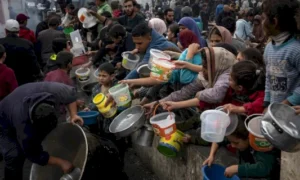How will we feed 9 billion people in 2050?
Food waste – a global problem wasting 1.3 billion tonnes of food a year
Estimated global population by 2050 means the planet will need to feed 9 billion people each year. At present, nearly 1 billion people go hungry every day – and yet we’re wasting 1.3 billion tonnes of food a year. Middle East Business looks at how the UN wants us all to do our bit to overcome this problem.
As we pass from one feast period to another, from Eid Al Adha to Christmas, we will certainly witness an increased amount of food being purchased and cooked. Eating with others is considered the most common enjoyable social habit people have practiced since the dawn of time.
In some cultures, it’s not the done thing to leave food on your plate (e.g. France), while in Arab countries it can be the polar opposite. Arab generosity has to be highlighted by the amount of food served, with numerous dishes providing a mountain of food. In fact, over-serving food at a meal is viewed as being a virtue in our region. But what is the destiny of the leftovers – the unconsumed food? It will either be eaten by the family the next day or, more often than not, go into the waste bin. This second destiny is regularly witnessed in some countries of the GCC, and especially so during specific periods of the year such as Ramadan and feasts.
This practice has led to developing countries getting rid of some $310 bn of wasted food (world wide total is 1.3 billion tonnes). Some people might underestimate the gravity of the situation. But it is an extremely serious situation that has to be dealt with. Some others see it as a business opportunity, a potential source for new recycling projects. But it does seem that they are blissfully unaware of the fact that it is notoriously difficult to treat or recycle food waste because of the high levels of sodium and moisture that it contains.
The economic loss due to this huge waste is enormous – it also harms the environment. This includes the waste of fertilisers and pesticides used to produce the food, money spent to produce and transport the crops, and what about the methane created by the waste? The wasted food ends up in landfills, already a harmful source of greenhouse gases that contributes to global climate change.
Some reactions about the wastage that occurs at meals to celebrate holidays were published on the web page of Worldwatch Institute in an interview on the Times Daily: “With the holidays upon us, we tend to cook too much, but there are simple things a family can do to prevent waste,” Myra Hickman, Tuscumbia City Schools’ child nutrition program director, said. “Pay attention to the yield in a recipe and make recipes that feed a large number only when you are preparing for a large group. It sounds simple, but so often families, especially those that don’t eat leftovers, throw away more food in the day or days after a meal than was consumed.”
FAO, the United Nation’s Food and Agriculture Organisation, published these alarming statistics about the culture of food waste. They are constantly trying to raise awareness of this problem and find solutions that can be easily put to use. Their campaign is “SAVE FOOD: Global Initiative on Food Loss and Waste Reduction”.
Key findings announced by FAO include:
Roughly one third of the food produced in the world for human consumption every year — approximately 1.3 billion tonnes — gets lost or wasted.
Food losses and waste amounts to roughly US$ 680 billion in industrialised countries and US$ 310 billion in developing countries.
Industrialised and developing countries dissipate roughly the same quantities of food — respectively 670 and 630 million tonnes.
Fruits and vegetables, including roots and tubers, have the highest wastage rates of any food.
Global quantitative food losses and waste per year are roughly 30% for cereals, 40 -50% for root crops, fruits and vegetables, 20% for oil, seeds, meat and dairy plus 30% for fish.
Every year, consumers in rich countries waste almost as much food (222 million tonnes) as the entire net food production of sub-Saharan Africa (230 million tonnes).
The amount of food lost or wasted every year is equivalent to more than half of the world’s annual cereals crop (2.3 billion tonnes in 2009/ 2010).
Per capita waste by consumers is between 95 – 115 kg a year in Europe and North America, while consumers in sub-Saharan Africa, south and south-eastern Asia, each throw away only 6 – 11 kg a year.
Per capita food losses and waste, at consumption and pre-consumptions stages, in different regions
Total per capita food production for human consumption is about 900 kg a year in rich countries, almost twice the 460 kg a year produced in the poorest regions.
In developing countries 40% of losses occur at the post-harvest and processing stages, whilst in industrialised countries more than 40% of losses happen at the retail and consumer levels.
At the retail level, large quantities of food are wasted due to quality standards that over-emphasise appearance. An example of this would be a fruit or vegetable rejected purely due to its appearance or size not fitting a certain criteria, but which is perfectly fine to eat.
Food loss and waste also amount to a major squandering of resources, including water, land, energy, labour and capital and needlessly produce greenhouse gas emissions, contributing to global warming and climate change.
The food currently lost or wasted in Latin America could feed 300 million people.
The food currently wasted in Europe could feed 200 million people.
The food currently lost in Africa could feed 300 million people.
Even if just one quarter of the food currently lost or wasted globally could be saved, it would be enough to feed 870 million hungry people in the world.
Food losses during harvest and in storage translate into lost income for small farmers and into higher prices for poor consumers.
In developing countries food waste and losses occur mainly at early stages of the food value chain and can be traced back to financial, managerial and technical constraints in harvesting techniques as well as storage and cooling facilities.
Strengthening the supply chain through the direct support for farmers and investments in infrastructure, transportation, as well as in an expansion of the food and packaging industry could help to reduce the amount of food lost and wasted.
In medium- and high-income countries, food is wasted and lost mainly at later stages of the supply chain. Differing from the situation in developing countries, the behaviour of consumers plays a huge part. The study identified a lack of coordination between actors in the supply chain as a contributing factor. Farmer-buyer agreements can be helpful to increase the level of coordination.
Additionally, raising awareness among industries, retailers and consumers as well as finding beneficial use for food that is presently thrown away are useful measures to decrease the amount of loss and waste.






















